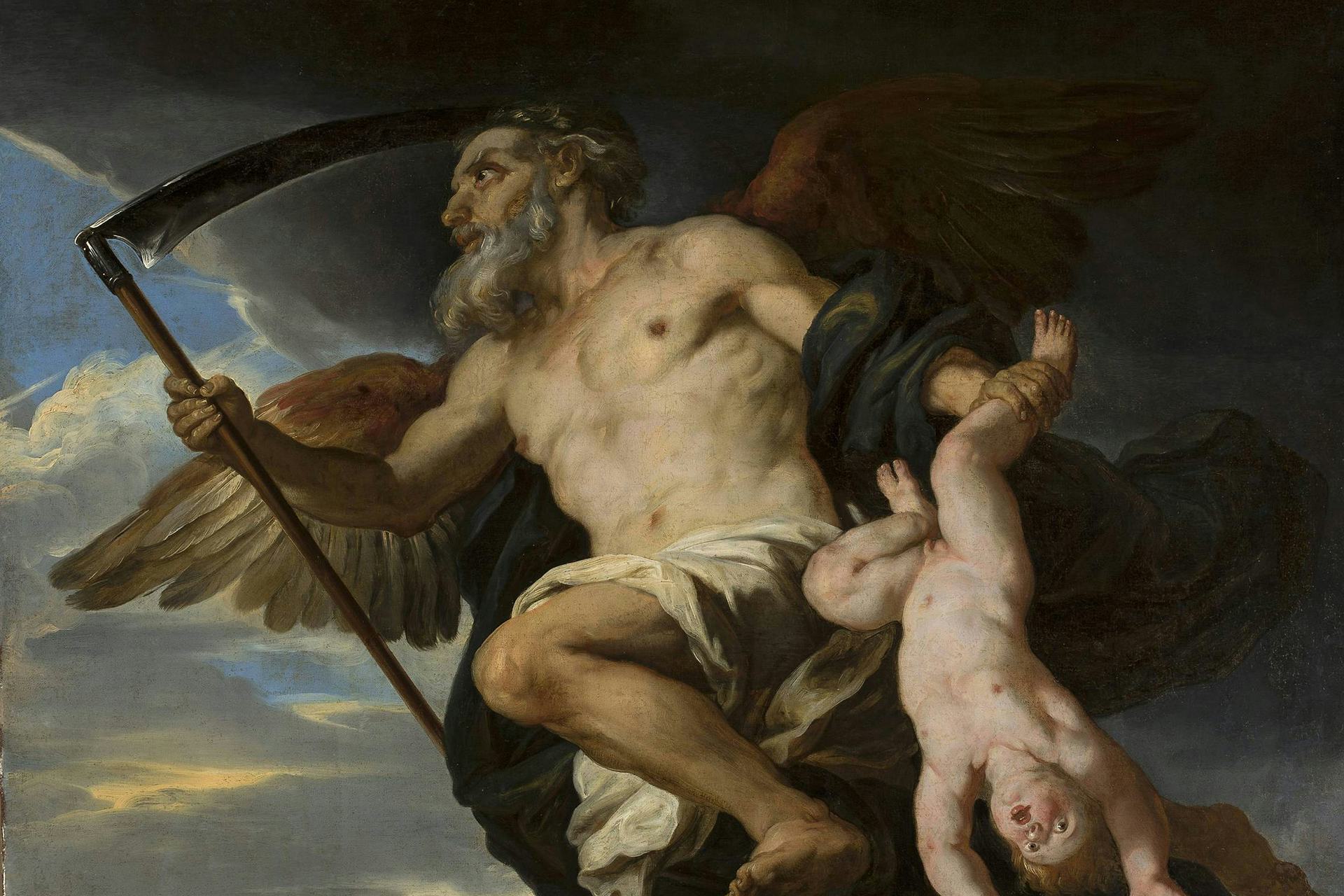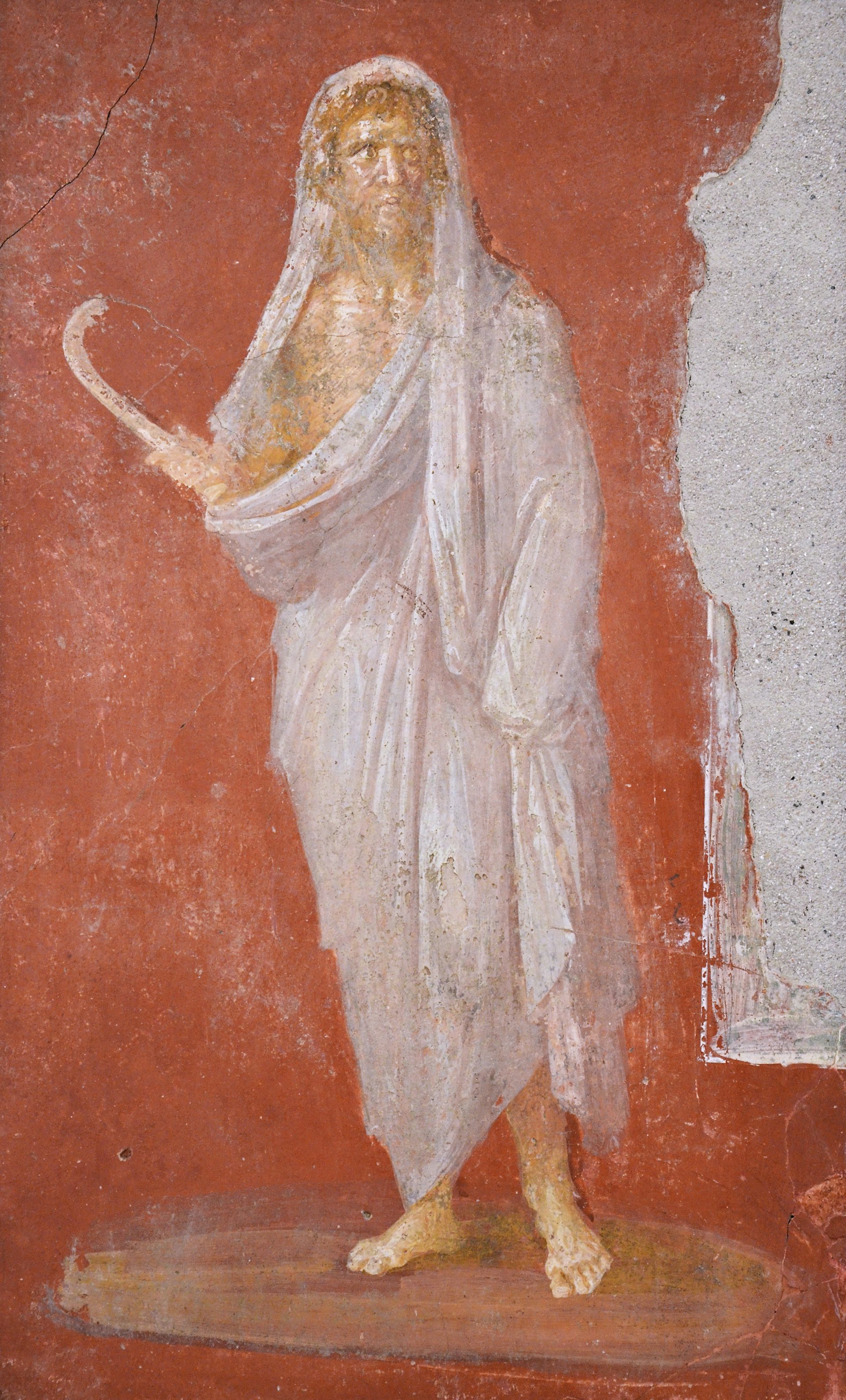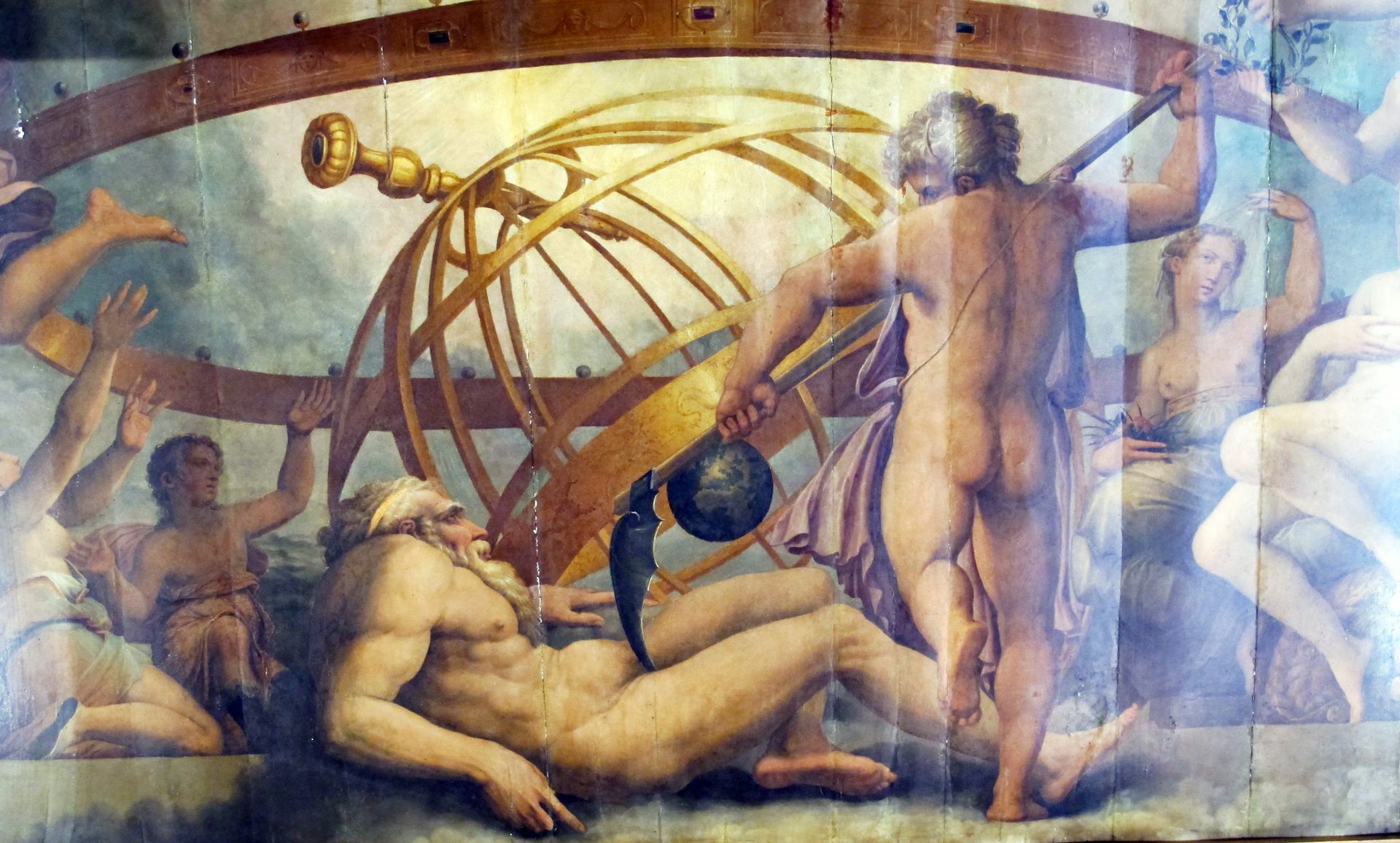Cronus

Overview
Cronus, the second ruler of the Greek cosmos, was a Titan known primarily for his cruelty and for usurping his father Uranus. He fathered the first of the Olympian deities, including Demeter, Hades, Hera, Hestia, Poseidon and Zeus. Insatiably cruel and hungry for power, Cronus was ultimately deposed by his son Zeus, who ushered in the era of the Olympians.
In Greek art, Cronus was often depicted wielding a sickle, a symbol of his rebellion against his father as well as his ties to fertility and agriculture. The Greeks of ancient Attica and Ionia celebrated Cronus during the Cronia, a harvest festival marked by indulgent consumption of food and drink and the mixing of social classes. In the Roman world, Cronus was known as Saturn.
Etymology
The origin of the name “Cronus” (Greek Κρόνος, translit. Krónos) remains uncertain. One theory has suggested a connection with the Proto-Indo-European root *(s)ker- (via the Greek verb κείρω, translit. keírō), meaning “to cut.” Such an origin would likely allude to Cronus’ severing of his father’s genitals, but may also refer to the “cutting” process by which the cosmos was created in some Indo-European mythologies.[1]
Another suggestion, no longer fashionable today, traces Cronus’ name to the Semitic root qrn, meaning “horn.” This etymology would make Cronus “the horned one.”[2]
Cronus’ association with time, first popularized by the Greek Orphics and later taken up by Renaissance Europeans, was purely coincidental. It emerged as a product of the similarities between the name Cronus and the Greek word χρόνος (chrónos), meaning “time.” The myth in which Cronus swallows his children can thus be understood as a metaphor for time, which “devours the ages and gorges [itself] insatiably with the years that are past.”[3]
Other fanciful etymologies for Cronus’ name were suggested by Plato in his philosophical dialogue Cratylus. For example, Plato conceived of “Cronus” as a kind of compound of the Greek words κοῦρος (koûros, “youth, young man”), καθαρός (katharós, “pure”), and νοῦς (noûs, “mind, intellect”). Plato’s Cronus is therefore “he of pure intellect.”[4] However, this etymology should be regarded as merely philosophically provocative, rather than linguistically or historically accurate.
English
Greek
Cronus Κρόνος (Krónos) Phonetic
IPA
[KROH-nuhs] /ˈkroʊ nəs/
Epithets
Cronus’ chief epithet, used a few times in Hesiod’s Theogony, was ἀγκυλομήτης (ankylomêtēs), meaning “crooked-counseling.” This distinctive epithet highlights Cronus’ wily but cruel nature.
Attributes
Functions and Characteristics
As the predecessor of Zeus, Cronus ruled over the cosmos before the Olympians wrested power from him and the other Titans. Cronus himself had seized the throne from his own father Uranus, the embodiment of the heavens. As shrewd as he was strong, Cronus was powerful enough to outmatch the great Uranus. In the Theogony, the poet Hesiod characterizes him as “Cronos the wily, youngest and most terrible of [Gaia’s] children.”[5]
Cronus and his Titan cronies ruled the cosmos, it seems, from Mount Othrys in central Greece, south of Mount Olympus.[6] After he was defeated and overthrown by the Olympians, though, Cronus wound up in Tartarus, the deepest pit of the Underworld, where he was imprisoned for the rest of eternity.[7] But other traditions put Cronus’ final home elsewhere, in the Isle of the Blessed or even in Britain (see below).

Saturn, the Roman Cronus, holds a scythe in this Pompeiian fresco (1st century CE).
Carole RaddatoCC BY-SA 2.0Cronus wielded a sickle (or scythe), a symbol that connected him with the world of farming. Indeed, Cronus was thought to hold sway over fertility and agriculture. In later eras, he was often associated with the Greek deity Chronos, “Time” personified, and thus depicted as the original “Father Time,” an old man with a scythe who controls the passing of the seasons.[8] Cronus represented the pre-civilized world, in both its negative and positive aspects. On the one hand, he embodied the chaos of primeval times, a period in which someone could murder their parents and even their own children, as Cronus did, with very few consequences. On the other hand, he was also associated with the innocence and bliss of the world when it was young, before the troubles and discontents of civilization took hold. The Romans especially regarded Cronus—or Saturn, as they called him—as the symbol of a lost Golden Age.[9]
Iconography
The oldest artistic representations of Cronus date from the fifth century BCE, though there is literary evidence suggesting that the king of the Titans was present in Greek art from even earlier.[10] Representations of Cronus can be found on coins, sculpture, relief, and, somewhat more rarely, on vase paintings or wall paintings.
Cronus was typically depicted as a mature male, with curly, stylized hair and a full beard, similar in appearance to his sons Zeus and Poseidon. At some point (it is not clear exactly when) Cronus’ iconography became characterized by a mantle or veil pulled over his head. He was often bare-chested.
Cronus’ iconographic attributes include the sickle he used to castrate his father (a Greek bladed weapon or agricultural tool known as the harpe). He sometimes also carried a scepter, especially when he was represented on his throne with his queen Rhea.
Family
Family Tree
Mythology
Origins
The myth of Cronus, like many of the Greek cosmogonic myths, is clearly based on Near Eastern models. Cronus’ rebellion against his father Uranus and subsequent overthrow at the hands of his son Zeus bears especially notable similarities with the Hurro-Hittite “Succession Myth,” where the sky god Anu is castrated and overthrown by Kumarbi, who is in turn overthrown by the storm god Teshub. The Greeks, who must have encountered this myth at an early date, adopted it for themselves, turning Anu into Uranus, Kumarbi into Cronus, and Teshub into Zeus.
The origins of Cronus himself have been deduced by some scholars from his role in religion. In ancient ritual, Cronus and his festival were associated with social reversal—specifically, the reversal of the roles of master and slave. This ritual seems to have originated in North Syria, and to have reached the Greeks as it was adopted by the people of Anatolia, especially the Hittites. The ritual of social reversal may be reflected in the myth of Cronus, the early god who is overthrown by his son.[24]
The Rise of Cronus
Cronus’s triumphant rise to power and spectacular fall from glory were cornerstones of Hesiod's Theogony. The last child of the primordial deities Uranus and Gaia, Cronus was born into strife, caused by his father’s paranoia and jealousy. Convinced that his children would one day rebel against him, Uranus imprisoned them in Tartarus, a hellish realm deep within the earth.[25]
Distraught by Uranus's tyranny, Gaia urged her children to rebel against their wicked father. When she offered them a flint sickle in the hopes they might take up arms, only Cronus answered her call. Hesiod described this exchange in the Theogony:
‘My children, gotten of a sinful father, if you will obey me, we should punish the vile outrage of your father; for he first thought of doing shameful things.’ So she said; but fear seized them all, and none of them uttered a word. But great Cronos the wily took courage and answered his dear mother: ‘Mother, I will undertake to do this deed, for I reverence not our father of evil name, for he first thought of doing shameful things.’ So he said: and vast Earth rejoiced greatly in spirit, and set and hid him in an ambush, and put in his hands a jagged sickle, and revealed to him the whole plot.[26]
The “plot,” as Hesiod refers to it, was as simple as it was severe. Cronus was to surprise Uranus, overpower him, and sever his genitals with the flint sickle. Though some versions of the myth claim that Cronus received help from the other Titans (all except Oceanus),[27] Hesiod has him acting alone:
Then the son from his ambush stretched forth his left hand and in his right took the great long sickle with jagged teeth, and swiftly lopped off his own father's members and cast them away to fall behind him.[28]
Uranus’ blood spilled onto the earth, and on the spot were born the Erinyes, the Giants, and the Meliae, while Uranus’ severed manhood was cast into the sea, where it mingled with the sea foam to produce the goddess Aphrodite.[29]

Detail of The Mutilation of Uranus by Saturn by Giorgio Vasari and Cristofano Gherardi (ca. 1540s–1550s), now in the Palazzo Vecchio in Florence, Italy.
SailkoCC BY 3.0The Fall of Cronus
In his triumph, Cronus ushered in the reign of the Titans, sometimes known as the Golden Age. Peace proved short-lived, however. Like his father, Cronus grew jealous and cruel. First, he banished the Cyclopes and Hecatoncheires to Tartarus, thus angering Gaia (just as Uranus had angered her by imprisoning her children).[30] Also like Uranus, Cronus came to suspect that his offspring, born of his sister-wife Rhea, would attempt to usurp his power. In an effort to prevent this calamity, Cronus ate each of his children as soon as they emerged from the womb. He would have eaten them all if not for Rhea, who substituted a rock dressed in swaddling clothes for Zeus, the last of her six children.[31]
He would have eaten them all if not for Rhea, who substituted a rock dressed in swaddling clothes for Zeus, the last of her six children. Under Gaia’s watchful eye, Zeus grew into maturity and rose up against his father. First, Zeus forced Cronus to regurgitate the other children—Hestia, Hera, Demeter, Hades, and Poseidon—whom Cronus had swallowed as soon as they were born.[32] Zeus and his siblings then banded together against their father and became known as the Olympians, so named for their home on Mount Olympus.
In the ensuing conflict, known as the Titanomachy, Zeus’ Olympian faction eventually won the day by enlisting the help of the Cyclopes and Hecatoncheires, whom they freed from their Underworld prison.[33] Zeus, the new king of the gods, then banished Cronus and the other Titans to Tartarus to suffer for all eternity.[34]
So, at least, ran the standard account, known most notably from Hesiod’s Theogony. But there were other versions of how Zeus overthrew Cronus. In one Orphic tradition, Zeus drugged Cronus with honey at the advice of the primordial goddess Nyx (“Night”), then bound and castrated him while he was incapacitated.[35] In another tradition, Zeus and Cronus fought hand-to-hand, and their battle was the first wrestling match at Olympia, the future site of the Olympic Games.[36]
In some traditions, the Titans were eventually released from Tartarus.[37] Cronus may have gone on to rule over the Isles of the Blessed, a blissful land of the afterlife enjoyed by the greatest heroes.[38] Other sources claimed that Cronus escaped from Zeus and came to Italy, heralding the beginning of a Golden Age there.[39] Others still said that Cronus lay in eternal slumber on an island beyond Britain, guarded by Briareus and attended by numerous daemons.[40]
Other Versions
While Hesiod’s version of Cronus’ mythology was the most influential in antiquity, it was hardly the only version. In the distinctive mythology of the Orphics, Cronus was one of the gods born from the primordial couple of Oceanus and Tethys (rather than Uranus and Gaia)[41] and the father of the Phrygian god Sabazius;[42] he was said to have been castrated and imprisoned by Zeus with the help of Nyx.[43] Through a subtle alteration to Cronus’ name, the Orphics (among others) turned the Titan into Chronos, “Time” personified.[44]
Later on, Cronus was apparently identified with the Egyptian god Geb, the primordial embodiment of the earth, for he was invoked as father of Isis[45] as well as Typhon (the Greek name for the Egyptian god Seth) and Nephthys,[46] all children of Geb and Nut in ancient Egyptian mythology.
A rationalized version of the myth of Cronus, set in Libya in north Africa, is related by the historian Diodorus of Sicily. According to Diodorus, Cronus, Rhea, and the other Titans were children of Uranus and Titaea. Rhea first married Ammon, a Libyan king, but then left him to marry her younger brother Cronus. Rhea later incited Cronus and the other Titans to wage war against Ammon, who finally fled to Crete. Eventually, Cronus’ tyrannical rule was ended by Ammon’s son Dionysus. Dionysus installed Zeus, the son (in this tradition) of Cronus and Rhea, as king of Egypt, and the two joined forces to defeat the rest of the Titans.[47]
Worship
Festivals
The most important of Cronus’ festivals was the Cronia, observed in several Greek cities. In Athens, the Cronia was held in the summer, during the month of Hekatombaion, the first month of the new year (in July).[50] The festival was associated with the harvest. It was celebrated at the temple of Cronus, located near the large temple of Olympian Zeus. The Cronia was marked by a carnivalesque atmosphere in which the social order was temporarily suspended, with masters feasting together with—or perhaps even waiting on—their servants.[51]
Cronia festivals were also celebrated in other cities. In Alexandria, for example, special cakes were baked and handed out at the temple of Cronus.[52] In Thebes, there was a festival of servants known as the Cronia which involved artistic competitions.[53]
Cronus was also celebrated in other festivals. Some of these were also associated with the harvest, just like the Cronia. Thus, Cronus was honored in Panhellenic initiation festivals that took place during the “dog days” of summer. In Thessaly, at the early rise of the “dog star” Sirius, there was a festival of Cronus on Mount Pelion in Thessaly, in a cave connected with Cronus’ son Chiron.[54]
Cronus was also sometimes worshipped in the spring. At Athens, he received offerings of cakes and sacrifices in the month of Elaphebolion (March/April).[55] In Elis, Cronus received sacrifices in the month of Kronion, which had been named after him, around the time of the spring equinox.[56] There were also months called Kronion after Cronus, usually in the summer or autumn, implying further festivals of Cronus during this time. In Rome, where Cronus was worshipped as Saturn, the god’s main festival was called the Saturnalia. Much like the Cronia, it was known as a time of carnival and revelry in which social norms were overturned: masters would wait on their slaves, gambling was allowed, and drinking and partying were practically required.
Temples
Cronus had a handful of temples in the ancient world. One was located in Athens, within the ritual boundary of the larger Temple of Olympian Zeus.[57] Another temple of Cronus, located in Olympia, was said to have been built by the mythical golden race that occupied the earth before humans were created.[58] According to one myth, the site on which this temple was erected had once seen an epic wrestling match between Cronus and Zeus.[59]
Cronus was also worshipped in mountain sanctuaries throughout Greece, Sicily, Italy, and even Libya. He also had an important temple in the forum of Rome, built around the beginning of the fifth century BCE, where he was worshipped as Saturn.
Finally, Cronus was closely associated with Apollo’s oracle at Delphi. In the heart of the temple was a spherical stone known as the omphalos. It was believed that the omphalos represented the very center of the world (hence its name, which is the Greek word for “navel”). This was allegedly the stone that Rhea had given Cronus to swallow instead of Zeus; when Cronus regurgitated his children, he first spat out the stone, which fell to earth at Delphi.[60] There was even one tradition that made Cronus the original owner of the oracle at Delphi.[61]
Human Sacrifice
Usually worshipped as the god of the harvest and a utopian Golden Age, Cronus also had a darker side that was sometimes put on display in his cult. The Greeks associated human sacrifice with Cronus. The Greeks themselves insisted that they no longer practiced such brutal rites,[62] though they often insisted that “barbarians” still sacrificed humans to Cronus.[63]
It was to the Phoenicians above all—and the Carthaginians in particular—that the Greeks attributed the practice of human sacrifice. Ancient Greek sources represented the Carthaginians as sacrificing children from noble families by laying them on the extended arms of a mechanical statue of “Cronus”—Baal to the Carthaginians—that would then roll them into a bronze pan where they were burned alive.[64]
Such accounts, however, may be no more than propaganda inspired by the various conflicts the Carthaginians had with the Greeks and Romans. In any case, there are also reports of human sacrifices to Cronus practiced in the Greek world, for instance in a festival on the island of Rhodes celebrated on the sixth day of the month Metageitnion (August/September).[65]
Pop Culture
Cronus has often been assimilated into Chronos, a deity associated with time, and the two eventually merged into the character of Father Time. This conflation is likely a result of the similarity between the name Cronus and the Greek word chronos, meaning “time”—a classic example of folk etymology. This also explains why the Father Time character often wields a scythe, an implement closely associated with Cronus.
Cronus is featured as a recurring character in the God of War video game series and serves as a major antagonist in God of War III (2010). In Rick Riordan’s Percy Jackson and the Olympians book series, Cronus appears as Kronos, a nefarious troublemaker who acquires an attitude after four thousand years of captivity in Tartarus. He leads an army of monsters to Mount Olympus in an attempt to topple Zeus’ Olympian regime.
Saturn, the sixth planet from the sun, is named after Cronus’ Roman equivalent.